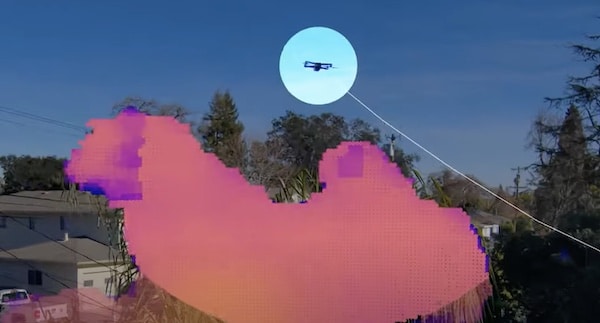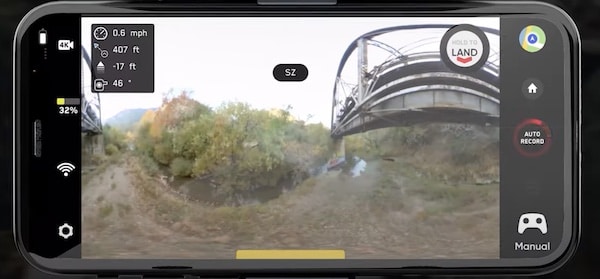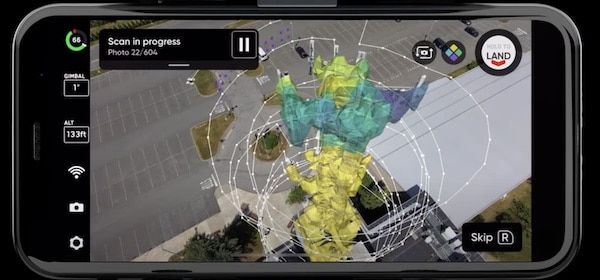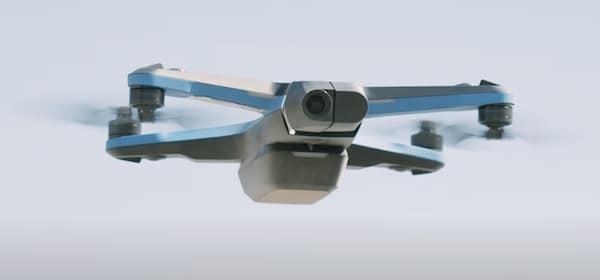The Skydio 2 is your personal camera crew. Built to get everyone into drones, the Skydio 2 uses the same advanced flight capabilities to keep new operators in the air that allows professionals to pull off impressive shots with ease.
Introduction:
Skydio started building drones with the goal of accessible autonomous flight for any operator. When they built, the Skydio R1’s goal was to eliminate crashes using collision avoidance sensors. At the time, it was one of the most advanced obstacle avoidance drones on the market. Flash forward to the end of 2019; the Skydio 2 was released with a complete design overhaul and improvements all around.
The Skydio 2’s autonomous flight abilities are unparalleled by other manufacturers. But with a 4K 60 fps video, the Skydio 2 is on par with video resolution for a top-end drone. The main selling point of this drone is the AI-assisted autonomous functionality, by far. Every other spec on this drone simply hits the average range for the drone market.
Skydio says to “focus on what you’re doing – riding a mountain bike, shredding snow, or lining up the perfect sunset shot – while your drone does the flying.” They sell the Skydio 2 as the intelligent drone “that will get you into drones” and they believe it opens the world of drones to anyone.
Feature Overview of the Skydio 2:
The Skydio 2 now comes in four varieties: Starter, Sports, Cinema, and Pro. While the Skydio 2 drone is the same in all four, each kit contains an increasing amount of accessories. Given the Skydio 2 is a few years old, the current sale may be foretelling the near release of the 3rd iteration of this drone- assuming they don’t move on to solely enterprise-grade drones. More on that later though.
The Starter Kit (available for $949 on sale at Skydio.com):
- (1) Skydio 2 drone
- (1) Battery
- (2) Extra propellers
- (1) USB-C Wall Charger
- (1) USB-C Cable
- (1) Microfiber Cloth
- (1) Hard-shell Case
The Sports Kit adds on (available for $1399 on sale at Skydio.com):
- (2) Batteries
- (1) Dual Battery Charger
- (1) 128 GB Micro SD Card
- (1) Skydio Beacon
The Cinema Kit adds on (available for $1799 on sale at Skydio.com):
- (2) Extra Propellers
- (1) Joystick Controller
- (1) Pro Hard Case
- (1) PolarPro ND Filter set
The Pro Kit adds on (available for $2599 on sale at Skydio.com):
- (2) Extra Propellers
- (1) Tablet adapter for Controller
Skydio Premiere Support
Noticeably, when compared to other manufacturers, the Skydio 2 only includes a controller in the two top-end kits. Showing Skydio’s commitment to the autonomous functions as the main control mechanism for the drone via the smartphone app.
Autonomous Flight:
Skydio promotes advanced autonomous flight as the main feature of the Skydio 2. With 360° obstacle avoidance powered by six cameras processing data through a computer vision system, Skydio believes the Skydio 2 can reliably fly itself well enough to not include a remote in the Starter and Sports kits. The omnidirectional obstacle avoidance is impressive and far surpassed the DJI equivalent when released, but with less frequent upgrades as DJI software, is it still as good today? The surprising answer is yes. The Skydio 2 keeps pace and even outshines the DJI ActiveTrack 3.0 in certain conditions. If you want a drone to self-record and flow along with outdoor pursuits, then it’ll be tough to beat the Skydio 2. While both the Skydio 2 and DJI systems primarily use optical sensors for obstacle avoidance, the Skydio 2 quantifies their image sensor abilities. Touting an impressive 4K resolution on all six of the obstacle avoidance sensors and a field-of-view of 200° on each camera. This gives the drone a high-quality image completely surrounding it. No other manufacturer gives the specification on the avoidance sensors used in their drones, but Skydio estimates the DJI sensors to be an order of magnitude less than their own.

With autonomous flight comes the selling point of the Skydio 2. The object tracking feature. The Skydio 2 drone does this in two ways: via image recognition and vis the Beacon. The image recognition is akin to other manufacturers’ active tracking, the main camera feed processed imagery to follow along with the target. While the Skydio 2 does this slightly better than others, it would be hard to tell in most circumstances. The big difference comes with the use of the Skydio Beacon. The Skydio Beacon is essentially a GPS tracking device you carry on the person or object to be followed so the drone knows where you are even if out of frame or obscured by the landscape. Videos of the Skydio Beacon in action show how impressive it is. Since this drone came out, other manufacturers have incorporated similar technology into their smartphone apps, leaving the tracking to be limited by the phone. The Skydio Beacon is included in the Sports, Cinema, and Pro kits. The autonomous flight modes are Motion Tracking, Fixed Tracking, One Shots, and Cable Cam. Motion Tracking is what we have talked about so far, following a moving target. Fixed Tracking is a tracking shot that is kept relative to the person- aka in front of or on a specific side, etc. One Shots are the cinematic-looking shots offered autonomously by every drone manufacturer, like dronie, rocket, boomerang, or vortex. Cable Cam flies between two set points, similar to the shots from a cable camera at a football game. It has a single pass, loop, or tracking setting to simulate a variety of cable camera shots.
The autonomous flight system is powered by an NVIDIA Tegra X2 SoC that has an impressive 256-core NVIDIA Pascal GPU, a Dual-core NVIDIA Denver 2 64-bit CPU with a quad-core ARM-A57 MPCore subprocessor, and 4GB of 128-bit LPDDR4 RAM. That’s the equivalent of a top-end tablet’s processing power just for the autonomous flight computer. Skydio claims the drone can actively track 10 subjects in frame and updates at 500 iterations per second, over 1 million points per second. Which all sounds impressive, certainly contributing to the outstanding tracking ability of the Skydio 2.
Image Quality:
Arguably the most important feature of any camera drone, the main camera. The Skydio 2’s main camera is a Sony IMX577 ½.3” 12.3MP CMOS sensor that shoots 4K footage at up to 60 fps. Specifically, 3840 x 2160 at 30, 60 48, or 24 fps and 1920 x 1080 at 120, 60, 30 fps. Giving you the ability to shoot slow-motion at 1080p at 120 fps. Still images use the entire resolution on the sensor, shooting 4056 x 3040 12MP images in JPEG or DNG (RAW). With 13 stops of dynamic range, images will be well balanced and not over or under-saturated. The built-in lens is a 20mm (35mm equivalent) with an f/2.8 aperture. The Skydio 2 has a bitrate of 100 Mbps, slightly slower than the DJI Mavic Air 2’s 120 Mbps- but arguably good enough. Videos are recorded in MPEG-4 with AVC/H.264 or AVC/H.265 encoding. Skydio doesn’t make its processors- listing the Qualcomm QCS605 SoC on its spec sheet. This is ideal as Qualcomm has an integrated AI engine on the chip for faster performance. Included in the Qualcomm QCS605 is their 64-bit octa-core Kryo 300 CPU and an Adreno 615 GPU, making this system-on-a-chip perfect for 4K capture and autonomous features. A smart move by Skydio. The three-axis gimbal mount for the main camera keeps the video footage steady in all types of conditions.
On paper, the Skydio 2 sounds like it takes excellent images, but how does it stack up against the competition? Fortunately, Skydio has done the hard work for us and published a 3rd party report from NomiCam comparing the real-world static image capabilities. In the report from September 2019, the Skydio 2 is put up against the DJI Mavic 2 Zoom, DJI Mavic 2 Pro, and DJI Mavic Air. The report has both objective results done analytically in their labs and subjective results for the reader to observe themselves. NomiCam reports the Skydio winning the color, noise, and dynamic range categories- the DJI Mavic 2 Pro beating out Skydio in the exposure and resolution categories. Of course, being at the end of 2021, these tests are slightly outdated with DJI’s release of the Mavic 3. Not to mention this report doesn’t cover video results. But a quick search on the internet will show you what the video looks like and how most users are critical of the video quality, despite the 4K resolution. Realistically, it is good enough for anything short of professional quality cinematography.
Controllers:
There are three controller options for the Skydio 2: the smartphone app for autonomous flight, the Skydio Beacon, and the joystick controller. With the smartphone app being the default control mechanism, Skydio recommends downloading the app to verify it works before purchasing the drone. However, it pairs with the drone easier than any other smartphone controllable drone. Kudos to Skydio there.

The Skydio Beacon is the next remote upgrade in the Skydio 2’s kits. It is a small handheld tv remote-looking device with a monochrome display and a few buttons. The integrated GPS sensors allow for the drone to track you more reliably than with the camera sensors alone, a feature seen first in the now-defunct Airdog drones. The Beacon uses GPS and GLONASS satellites for tracking, giving a reliable signal for the Skydio 2 to follow. In ideal settings, it has a range of 1.5 km for remote control operations.
The joystick controller is your basic drone remote; two joysticks and a smartphone holder. Since Skydio is all on board for the autonomous flight, they didn’t even make the controller, instead (assumably) licensing the same controller as Parrot uses for the Anafi series of drones. The optional tablet adapter simply attaches to the smartphone holder on this controller. More and more, top-end drones seem to be coming with less feature-rich controllers, instead opting for the features to be app integrated- and that’s no exception here for Skydio.
Artificial Intelligence:
Let’s talk AI for a moment. What is it? How does it help the drone? And why? Onboard AI means that the drone is already carrying a trained AI model that it can use to predict environmental changes around the drone. This makes the obstacle avoidance more accurate or predicts where you are moving. Essentially all the reasons the autonomous flight and obstacle avoidance on the Skydio 2 are due to the integration of onboard AI. The same AI computing technology is on the Skydio 2, Skydio 2 Enterprise edition, and Skydio X2. Skydio even offers a software upgrade package, Advanced AI Skills, as an aftermarket add-on for commercial, defense use- showing the ability of the onboard AI is only scratching the surface of what they can do.
The AI-augmented flight makes for buttery smooth flight capabilities when manually controlled as well. The joystick controller, while not the best, is adequate. It does its job and nothing more. With the AI-assisted obstacle avoidance, the beginner operator can fly as smooth as a seasoned pilot- evening out any jerky motions and navigating around unanticipated objects.
Battery Life:
A single battery gives about 23 minutes of flight time to the Skydio 2. Below average for a high-end drone. The DJI Mavic 3 has an advertised flight time of 46 minutes on a single battery. It’s closer to the original Mavic Air on flight time (25 minutes) than the Mavic Air 2 (34 minutes). For the same cost as the Starter Kit, you could get a DJI Mavic Air 2 Fly-More combo with 3 batteries. The battery connects via a unique magnetic mount system. Running six 4K cameras and actively processing all that imagery likely makes the biggest difference battery-wise, compared to similar drones. The tradeoff for unparalleled autonomous flight capabilities. This is the biggest drawback of the drone, 23 minutes severely limits the creative potential for the Skydio 2.
Size and Weight:
The Skydio 2 is 8.8” x 10.7” x 2.9” (or 223 x 273 x 74 mm) in size, slightly smaller than an unfolded DJI Mavic 3. However, the Skydio 2 has fixed arms, so it’s not as portable as some other options. Folding propeller brings the packing size down a little. Weighing in at 775 g (1.7 lbs), it does weigh less than the Mavic 3. However, when compared against the Skydio R1, it is a massive improvement in size and weight. The R1 was a flying pizza box at 13 x 16 x 1.5 inches and weighed almost 1000 grams (2.2 lbs). The redesign was much needed and now looks like a high-quality product.
Skydio 3D Scan, enterprise drones, and Geopolitics:
Not a feature of this drone, but I think it provides clarity as to the design goals of the Skydio 2. Skydio makes a 3D Scanning software aimed at inspections and other enterprise-type use. The Skydio 2 seemed to be a proving ground for the capabilities of their software and the basis for their enterprise-grade drones, the Skydio 2 for Enterprise and Skydio X2. When US departments (like the Department of the Interior, Armed Forces, and the Pentagon) blacklisted DJI from being used in official capacities it created a power vacuum for other manufacturers to get government contracts in. With the US-based Skydio official release of the X2 this year and seeing the incredibly similar specs to the Skydio 2, it somewhat explains why the software behind the drone is so much better than the overall product. Are enterprise and federal contract level drones Skydio’s current goal? Hard to say, but that seems to be one direction the company is moving in.

Pricing:
With prices ranging from just under $1000 to almost $2600, this drone has a range of price points to evaluate. With the Skydio 2 Beacon selling for $219 and the Skydio 2 Batteries selling for $115 separately, the Sports Kit is essentially giving you a free MicroSD card and dual battery charger for free in the kit. The Joystick controller is $179, PolarPro ND Filters are $69, and the Pro Case is $229 when bought alone. Making the Cinema Kit come in at a discount of $91 with the extra propellors. The Pro Kit is the only one where the accessories are not able to be bought separately, at least as of writing. However, Skydio offers upgrade kits as well. The accessory upgrades are prepackaged bundles that include all the extra accessories needed for the package but at a slight upcharge. The Upgrades will be $100 more than the kit would have been if bought upfront. Not quite as good of a deal.
My recommendation would be to buy the kit that includes everything you want upfront and nothing you don’t. If you never plan on using the joystick controller, for example, but want the hard case and ND filters- get the Sports Kit and those two accessories. That’ll save you $100 off the Cinema Kit on top of the Sports Kit savings, all without extra gear to sit unused. Comparing prices to Skydio’s biggest competitor, DJI, prices seem to land somewhere between fair and high for what you get. Be sure the Skydio 2 is the drone for you before buying.
Conclusion:
Skydio makes potentially the best “follow me” drone on the market technology-wise. On paper, it seems like a great drone, but in the transition from paper to reality- it misses the mark, slightly. The 4K 60 fps footage should be better than it is, and it’s quite limited by flight time. Skydio knocks it out of the park with its autonomous features, even years later. Skydio’s goal as a company is to make drones accessible to anyone, regardless of experience. They’ve accomplished that masterfully through the obstacle avoidance technology they’ve developed and integrated into the second revision of their flagship drone. The physical size and design of the Skydio 2 are a huge improvement from the original R1 drone, but still large when compared to a folding drone like a DJI flagship. Overall, I have a mixed review of the Skydio 2. It would be nice for Skydio to give DJI some real competition, but unfortunately, the Skydio 2 doesn’t check enough boxes for me to recommend it outright over any DJI product.
This all-around drone is outstanding in AI capabilities and autonomous flight. The physical design is great too. Everywhere else, the Skydio 2 is just average. Average doesn’t necessarily mean you shouldn’t go for this drone though. The Skydio 2 is for the person who wants a drone that can autonomously record the operator reliably with minimal input control-wise (or, you know, the commercial company that wants to use the 3D scan software or one of Skydio’s other advanced software packages). The Skydio 2 is a great drone if your number 1 priority is autonomous flight, and you are not looking for professional quality footage or long flight times.

